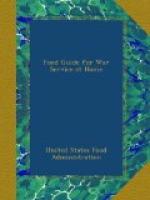Of course, sugar is a food, as it is burned in the body for fuel. But there are two good physiological reasons for avoiding excessive amounts. If we eat a large quantity in candy after already sufficient meals, we are overeating and may suffer from digestive disturbances in consequence. Eating sweets instead of other food is also bad and a cause of undernourishment. Sugar is pure carbohydrate, and although we may eat enough to satisfy the feeling of hunger the body will lack minerals, protein, and other substances absolutely necessary for its well-being. The person may feel satisfied, but he will be undernourished nevertheless.
The conservation of sugar will not only permit a fair distribution to our associates in the war, but insure a sufficient amount for our own men. It is especially valuable for them because it burns so rapidly in the body that it gives energy more quickly than other foods.
CHAPTER VII
MILK—FOR THE NATION’S HEALTH
In war-time there is constant danger of letting down the health standard. Food is high in price, demands on incomes are many and insistent, worst of all, life is being expended so freely abroad that we become careless about it at home. But while we are fighting to make the world a decent place to live in, we must keep up our health and vigor at home.
MILK IS VITAL TO NATIONAL HEALTH AND EFFICIENCY. We can conserve wheat and meat, sugar and fats, and be none the worse for it, but WE MUST USE MILK. The children of to-day must have it for the sake of a vigorous, hardy manhood to-morrow. A quart for every child, a pint for every adult is not too high an ideal.
There is no lack of evidence that children suffer if they do not have enough. In New York in this past winter, two things were observed which are undoubtedly closely connected—increased undernutrition among school children, and decreased use of milk. The Mayor’s Milk Committee in the fall of 1917 reported that the city as a whole had cut down its milk consumption 25 per cent, and certain tenement districts 50 per cent. The majority of the families who had reduced the milk to little or none were giving their children tea and coffee instead—substituting drinks actually harmful to children for the most valuable food they could have.
About the same time as the milk investigation, a count was made of the number of New York children who were seriously undernourished— half-starved. Twelve were found in every 100 children, twice as many as the year before.
The warring nations in Europe fully realize the value of milk. In the face of a serious shortage they are making every effort to get to the children as much milk as can be produced or imported. Until children, mothers, and invalids are supplied, no one else may buy any. For adults, milk is an almost unknown luxury.




